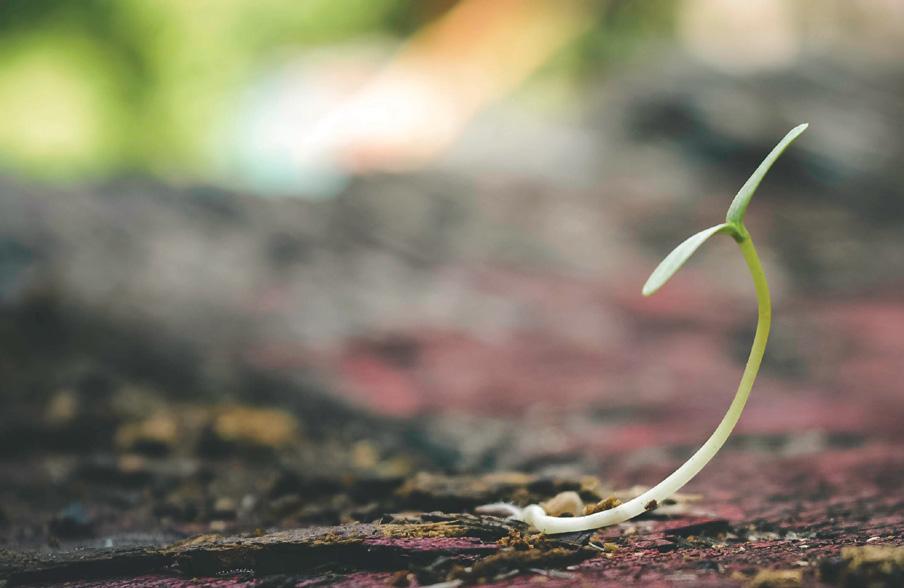
27 minute read
Seedbanks: Caring for the Future
Article by Jessica Kirby
“I don’t think we have the option of despair. Hope is a duty. It is something we cultivate with daily consciousness through our actions.” —Vandana Shiva, environmental activist
Advertisement
There are more than 1,000 seed vaults around the world—places where natural and heirloom seeds are stored, saved, and studied in a global effort to preserve them. They are both a symbol of hope and of worry, but most importantly, they introduce tangible acknowledgement of the importance of biodiversity.
Seeds vaults are as diverse as their regions. The Millennium Seed Bank Project, located at the Royal Botanical Gardens, Kew, United Kingdom, currently stores samples of the country’s entire native plant population, including several hundred endangered species. The oldest seed bank in the world is the Vavilov Institute of Plant Industry in Russia. It was established in 1894 in St. Petersburg and is named after Nikolai Vavilov, a Russian biologist and plant breeder who was one of the first scientists to understand the importance of crop diversity.
The Berry Botanic Garden in Portland, OR, houses seeds from endangered plants of the Pacific Northwest; the International Center for Tropical Agriculture in Colombia holds cassava, forages, and beans; and The International Potato Center in Lima, Peru is home to various potato species. The International Institute for Tropical Agriculture in Nigeria preserves groundnut, cowpea, soybean, and yam, and the International Rice Research Institute in Los Banos, Philippines, is a place for preserving— you guessed it—rice.
The world’s largest and most famous seed vault is Svalbard Global Seed Vault on Spitsbergen, part of Norway’s Svalbard archipelago, and it may one day save our lives. Millions of seeds representing more than 930,000 varieties of food crops are stored in this incredible building, constructed in an abandoned Artic coal mine.
“Inside this building is 13,000 years of agricultural history,” said Brian Lainoff, lead partnerships coordinator of the Crop Trust, which manages the vault, in an article in Time magazine.
The Vault was built a decade ago as a safeguard—if a nuclear war or global warming, for instance, threatens specific crops, governments will be granted access to seeds from the vault to restart their agricultural industries. In 2015, researchers withdrew seeds from Svalbard to create seed banks in Morocco and Lebanon after the region’s central seed bank in Aleppo, Syria, was damaged during the country’s civil war. The seeds have since been regrown and were redeposited at the Vault in 2017.
Closer to home, in April 2019, a labour of love with seeds at its heart began a new chapter in Southern Ontario. The Heirloom Seed Sanctuary, tended for two decades by the Sisters of Providence of St. Vincent de Paul, holds nearly 300 varieties, some of which date back to the 1500s.
Its seeds are being gifted to the Kingston Area Seed System Initiative (KASSI) and to Ratinenhayen: thos—which in Mohawk means, “They are farmers of seeds”—based in the Tyendinaga Mohawk Territory west of nearby Napanee.
The Heirloom Seed Sanctuary began in 1999 at the Sisters of Providence property in Kingston, Ontario, with a collection donated by Napanee farmers Carol and Robert Mouck. “Now it is time for the sisters to cease this ministry, to let the descendants of the original seeds to move again to responsible and caring organizations,” said Sister Sandra Shannon at a ceremony during which the seeds changed hands.
“We have confidence that the seeds have found, once again, good homes in which they will be treasured for the future,” said Shannon in a story in the Kingston Whig Standard.“It is with pleasure that we pledge that we will pass these seeds on.”
Cate Henderson is head gardener at Sisters
of Providence and the lead on the Heirloom Seed Sanctuary for 11 years. She is also as a founding member of KASSI.
“What drew me to this ministry was the knowledge that I am a seed,” Henderson said. “And in fact, we are all seeds. We are each a cell in the vast body of life, distinct, yet intimately bound up with all living beings. We cannot exist without others, and they are affected by everything we do. Therefore, all living beings are important, and their happiness and freedom are also important. This is the wonder of creation. This is why this ministry has been so important to me.”
As the importance of preserving seeds spreads across the globe, the political world is listening. The United Nations approved the Declaration on the Rights of Peasants and other People Working in Rural Areas on December 17—the product of nearly two decades of diplomatic work led by the international peasant alliance La Via Campesina. It formally extends human rights protections to farmers whose “seed sovereignty” is threatened by government and corporate practices.
According to a news release from the United Nations, “As peasants we need the protection and respect for our values and for our role in society in achieving food sovereignty,” said Via Campesina coordinator Elizabeth Mpofu after the vote.
The challenge moving forward will be to mobilize and empower small-scale farmers to claim those rights and take action against rich-country crop breeding regulations adopted into less developed countries, where the vast majority of food is grown by peasant farmers using seeds they save and exchange. Eco-activist Vandana Shiva has been called an environmental hero for her actions in support of her mission to fight genetically engineered foods. She created Navdanya or Nine Seeds, an organization that has established over 100 seed banks in India. She also lives on her own farm where she saves seeds and has cultivated more than 250 species.
Vandana Shiva spoke to Mary Hines on the CBC’s Idea Tapestry about the state of the earth and the power of individual actions to make a difference. Despite the world having lost 60 percent of its wildlife species since 1970, Shiva finds hope. “Ninety-three percent of our cultivated species have been lost since 1970, but saving seeds has reversed the trend,” she says. “Natural trends are irreversible, but trends caused by human irresponsibility can be turned around.”
This optimism and reverence for the earth and its bounty are the premise of Shiva’s work, which is so vast it spans a Canadian degree in mechanical engineering to small plot farming in India. To say she is knowledgeable is an understatement, and to buy into her critics’ view that she is romanticizing farming is naive. It all begins with the seed—literally and figuratively. We may look at the world’s state with despair, but there is beauty in small action, Shiva says. “Seeds are small. Saving seeds is a small action. But as a global shift from the idea that GMO seed is inevitable and patentable, that monoculture is inevitable, that little seed brings a mind shift of celebrating biodiversity and becoming co-creators and co-conservers.” The secret is creating beauty, which is not found in the work of drudgery. “The creation of beauty to regenerate the earth—to do that we have to shift from the idea of work as money and engaging in destruction and towards the creation of beauty that nourishes us and the earth,” Shiva says.
No matter what happens, we have responsibilities to each other and the earth, including the preservations of joy and flowing with the paths that are laid out for us, she says. “We can look at collapse in despair and say, ‘Oh my god, we are going over the precipice!’ or you can take that one seed and plant it, and ask everyone around you to plant seeds—seeds of joy, love, and hope. “People like Steven Hawking say there are only two options: extinction or escape. But there is a third option: caring for the world.” -GG
Jessica Kirby is a freelance editor and writer covering the environment, lifestyles, and the built environment for publications across Canada and the United States. She can usually be found among piles of paper in her home office or in the Vancouver Island wilderness enjoying nature's incredible bounty.

— LOCAL FOOD QUESNEL — Guardian of the Vegetables:
Seed Talk
During my workshops I am often asked what the difference is between GM seed, hybrid seed, organic seed, heirloom or heritage seed, and open-pollinated seed. Here is my short answer: Genetically modified (or GM) seed has been altered in a lab so that the plant will have certain characteristics that misguided growers think they want (my bias is showing, I know). This seed is always patented. Crops from GM seeds may or may not produce food that is fit to eat; it seems the jury is still out on that one. There is an equal amount of propaganda from both sides claiming that GM food is either totally safe and healthy or that GM food will definitely kill you. My issue with generically modified organisms (GMO) is that as these crops inevitably cross-pollinate natural species, the offspring become increasingly less viable, and we risk contaminating naturally bred seed, which would mean that we could become completely reliant on giant corporations for food and biodiversity would be compromised. My other issue is that these seeds are usually bred so that growers can spray the heck out of them and grow them in huge monoculture systems, and this sort of growing depletes the soil, contaminates the water, and destroys ecosystems.
Hybrid seed is a bit confusing. Hybrids are not GMOs. Hybrids are created by crossing two different varieties within the same plant species to try to get specific characteristics simply using pollination. Here’s an imaginary example: kohlrabi and cabbage are the same species and can crosspollinate even though each plant is quite different. Their offspring could be something completely different than either parent, or something similar to one of the parents but with different characteristics (like faster growth). We will call this imaginary offspring a kohlage. The kohlage may be a wonderful plant and have many great features, but if you saved the seed of the kohlage, it may grow something odd or it may just throwback to one of its parents’ types, if it germinates at all. It may not, because all of the kohlage seed you purchased will be genetically identical, and we know that genetically identical things should not breed.
There is nothing ‘wrong’ with hybrid seed. You will want to buy new seed each year,but unless it is patented, it is not illegal to save the seed from hybrids. Hybrids are often resistant to disease and have other advantages like being ready to harvest all at once. These advantages are known as “hybrid vigour.” You can tell a plant is a hybrid in a seed catalogue by the symbol: (F1). Hybrid seeds are sometimes patented.If it has a © symbol after its name, then it is patented. I grow a combination of hybrid, open-pollinated, and heritage seed, but I never buy patented seeds just on principle. I don’t believe in patenting life. I do understand that a lot can go into breeding a plant with specific characteristics, and I understand wanting to protect it. But I believe more strongly in protecting biodiversity and the importance of seed saving as so many varieties of important plants are disappearing rapidly.
Open-pollinated seeds come from two parent plants that are alike. To continue with my above example, both parents of open-pollinated seeds would be either a cabbage or a kohlrabi, but not one of each. Open-pollinated seeds can be saved, and their offspring will be true to type. Openpollinated seeds are represented by the OP symbol in your seed catalogue. Since 1985, patents have also been allowed on open-pollinated seeds.
Heritage seed and heirloom seed are interchangeable terms.These seeds are all open-pollinated and must have been in cultivation for a set amount of time. How long is still open for debate. Some say 100 years and others say 50 years, and still others argue that it’s not the number of years, but rather, that the seed must predate the mass plant hybridization that began after WW II. Heritage seeds will have unique characteristics and will often perform well in a specific environment. They are not always as easy to grow as hybrid seed. They often produce distinctive and tasty produce.
Organic seed comes from plants that were grown organically, and while you may not think this matters since you are not eating the seed you are planting, remember that if you are growing organically, you are buying the best seed to grow using organic methods.If you care about organic practices, then you probably also want to support the existence of organic seed.
Saving seed from year to year allows a gardener to develop plants that are adapted to the specific area where that gardener lives. Over time these carefully cultivated varieties will out-perform other varieties of the same plant because they will develop characteristics uniquely suited to where they grow. -GG An erstwhile market gardener and mother of goat, Terri lives on a small farm near Quesnel, BC. There she gardens, makes art, writes about local food, teaches workshops, and works at Long Table Grocery as Guardian of the Vegetables. Article by Terri Smith
A few of my favourite heritage seed varieties saved from my garden (clockwise from top left: Painted Mountain corn, Little Marvel shelling pea, Tohya soya bean, dwarf sunflower, Hungarian pepper, Romanesco zucchini, and a purple bean. Photo credit: Terri Smith
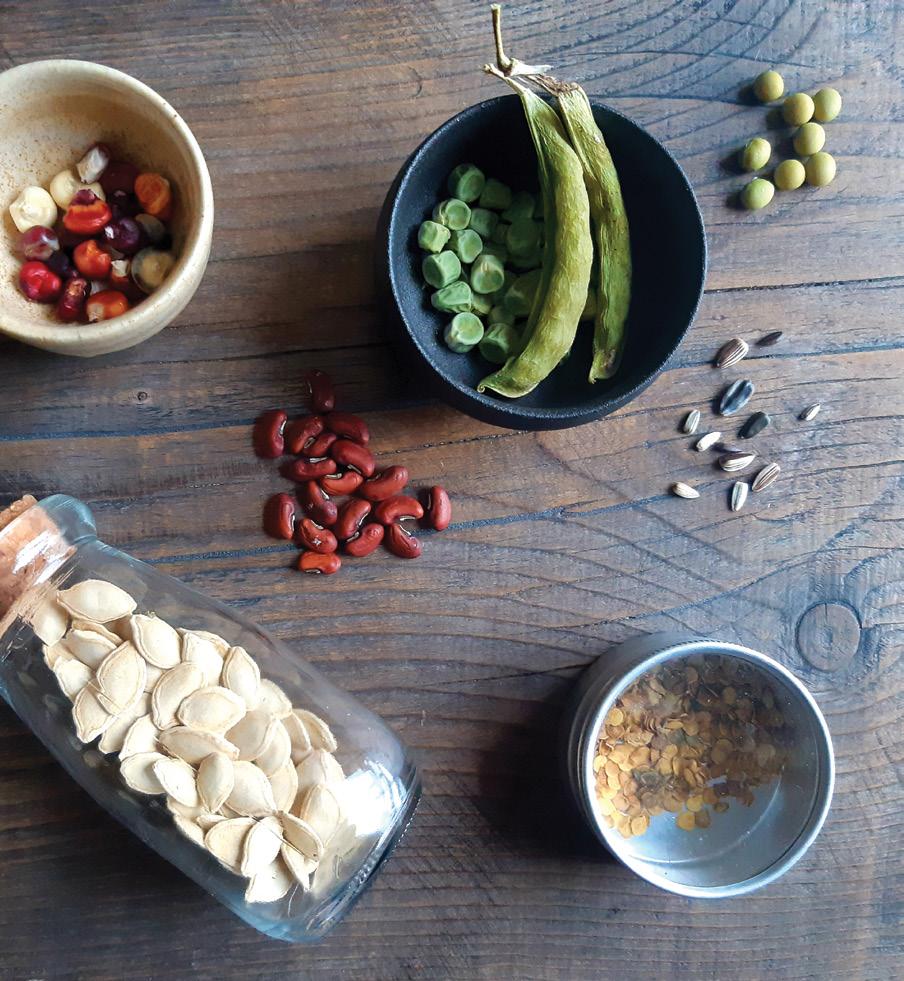
Good Green News for a Change: Five Examples of Hope in Action
Article by Erin Hitchcock
The devastation happening to our world is scary to say the least, but we mustn’t allow ourselves to become overwhelmed by the darkness when so many others are working to illuminate it.
People all over the world are pooling together to heal our planet, be it Greta Thunberg and the Fridays4Future movement that has led to millions of people calling for climate justice, or the individual seeking out ways to have a smaller footprint. Finding examples of hope in action helps propel us forward in creating the peaceful and healthy future we want for this world. This column is about focusing on examples of changes for good happening all around us.
I was fortunate to be present at World Religion Day in January in Williams Lake, which was held to support unity across all religions. Spiritual representatives from the Sikh, Christian, Bahai, Muslim, First Nations, and Buddhism communities all shared their prayers for peace, love, and healing for us all. This coming together of faiths was so moving, as it showed how we can all put aside our socalled differences, as we all share the same moral commonalities and are part of the same sentient family.
This is perhaps one of the most important things we can do as individuals, because peace won’t come on its own. So, a first example of good news for change is to strive to practise peace and kindness every day. As Charles Eisenstein says in his new book, Climate: A New Story, we need to “expand the circle of compassion to include every being on this earth.”
Springtime is the perfect time to witness the unity and symbiosis nature practises every day. We can help by giving back with extra compassion for ourselves and for the rest of Earth.
Actor, producer, and philanthropist Morgan Freeman recently converted his 124-acre
ranch into a bee sanctuary to help the bees, which are in danger due to many factors including habitat loss, colony collapse disorder, and pesticides.
While we don’t all have the land or the means to do what Freeman has done, we can still help the bees and other pollinators by creating pockets of habitat and food for them where we can, and by reducing or eliminating foods and products that contain chemicals such as glyphosate.
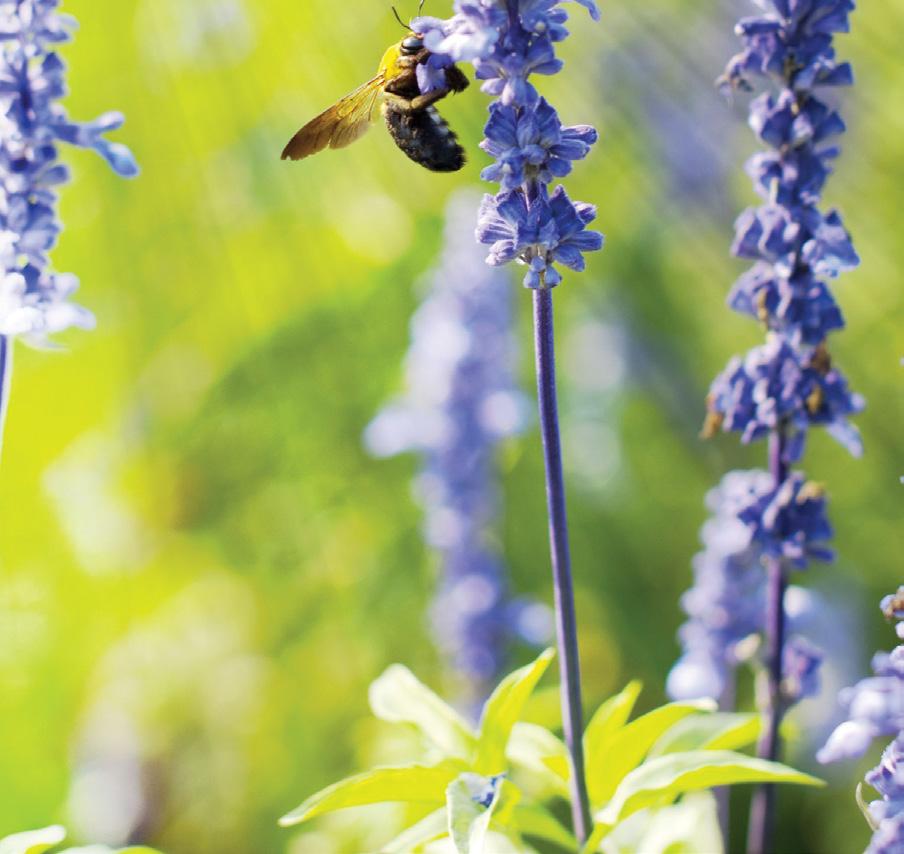
If you don’t already have a garden, consider planting one, even a small box or some pots if you lack space, and include flowers when planting—pollinators especially love lavender, bee balm, fireweed, dandelions, and many others. You can also set up bird feeders or (properly made) bee houses. I purchased a beautiful, well-crafted bee house made locally in Quesnel by Pause to Feather Creations. And remember, when feeding the hummingbirds, to make your own solution using sugar and water, rather than the solutions made with red dyes, which are actually poisonous to the birds we are trying to help. (I also found a neat little post about repurposing chipped tea pots by hanging them up to provide shelter for birds. It is always best to repurpose something you already have rather than to buy new).
Another way to help the birds and other wildlife is to reduce your use of plastics, which can kill birds and wildlife if ingested and also contribute to climate change when they’re produced.
The Ocean Cleanup Project is also providing hope after capturing and removing plastic, including microplastics, from the Great Pacific Garbage Patch, with its huge, plastic capturing floating device. The Dutch non-profit is set to deploy more devices to the mouths of the most polluted rivers to stop many of the plastics from entering the oceans.
The City of Williams Lake is still working on plans to ban single-use plastics in the city, and the provincial and federal governments are also working on legislation to ban certain plastic items.
But we shouldn’t wait for the laws to change. Avoid plastic whenever and wherever you can. Remember your reusables: coffee mugs, water bottles, metal straws, take-out containers. One of the best ways to prevent the Earth from choking on plastics is to not use them at all. Recycling is great but reducing or eliminating is key.
Finally, trees. CBC reported there are plans to plant 310 million trees this year alone in BC, in response to the mountain pine beetle, forest fires, and climate change. Most of the trees will be planted in the Central Interior, Cariboo-Chilcotin, and East Kootenay regions. Countries including Ethiopia, Scotland, and India, among others, have also been taking similar initiatives.
Each one of us can do our part for the planet, shaping a better future by how we choose to live and give back so we can contribute to a healthier planet for all. -GG
Erin Hitchcock is a stay-at-home mom, environmental activist, and member of the Cariboo-Chilcotin Pachamama Alliance and the Williams Lake Climate Action Coalition.






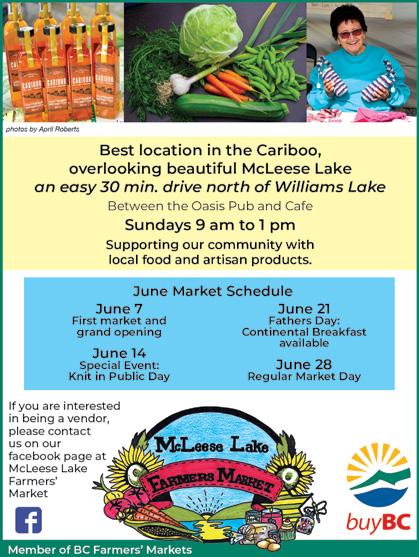
Normally, I avoid deep sky observing around the full moon. It takes centre stage, washing out all the faint fuzzies. Only the brightest stars are visible; like seeing would be from downtown Vancouver.
The full moon is very bright in an astronomical telescope, which is designed to gather as much light as is practical. In my 5" refractor, which has exquisite optics, the view is like what you would see if you were 2000 km away. Features from 2 km and up would be visible. You can see the very smooth area of Mare Tranquillitatis, where Apollo 11 landed. No sign of the actual landing, of course.
The moon is soooo stark! You don’t get deep shadows at full moon, but you do see the maria, the darker areas once thought to be oceans. The bigger craters are visible, starting with Plato, then Archimedes, Copernicus, and then Tycho, with its magnificent ray system.
The features visible on the moon are always changing with the phases. There is so much detail visible, it’s overwhelming. You owe it to yourself to see the moon in a good telescope at least once. No photograph or TV documentary can convey the reality of looking at it where it actually is.
Just for fun, I checked out the Pleiades, the famous open cluster in the shoulder of Taurus. I could barely make it out with the naked eye due to the moon’s brightness, but the scope showed the ‘diamonds on black’ look of it.
I tried unsuccessfully to see the pup, which is a companion star to Sirius, the brightest star in the sky. But the air turbulence revealed a dancing blob.
The star Betelgeuse, in Orion, is a red supergiant very near the end of its time. It will go supernova sometime in the next 100,000 years. Although it is known to be variable, it has become unusually dim since last fall. This is quite visible. You can see that it is about the same brightness as Bellatrix, which is next to it and is considerably dimmer than Rigel, in Orion's foot.
The dimming could be due to a carbon build-up in its atmosphere. In other words, it’s sooty. There is some speculation that it might blow soon, but I wouldn’t hold my breath.
That’s Venus in the SW sky in the evening. It will be its farthest from the sun on March 24. On April 3 it will pass thru the Pleiades. Worth checking out with binoculars. Saturn, Jupiter, and Mars are close in the predawn sky. This is the year for a close approach of Mars Skywatch with Bill Irwin
in October. It’s going to much higher in the sky this time, and this will be one of the closer oppositions. More on this later.
Let’s hope for some good weather this year and a smoke-free summer. There’s lots to see up there. You are welcome to join us at Bells Lake Observatory near Horsefly. I can be reached at irwin8sound@gmail.com. If it’s cloudy, you are welcome to check out my gallery of speaker system designs, all solar powered. -GG

Advertise with us! www.thegreengazette.ca

The Vision for a Natural Burial Sanctuary in the Cariboo
Article by Nicola Finch, Cariboo Community Natural Burial Association
“There is no reason why the plans we make around our own burial or cremation cannot be in keeping with practices that are supportive of nature and mindful of the environment.” —Green Burial Society of Canada T he Cariboo Community Natural Burial Association is a new nonprofit organization based in Williams Lake. Our purpose is to establish a natural burial sanctuary here in the Cariboo.
Natural or green burial at its most simplistic is direct burial in the ground in a manner that does not inhibit decomposition. There is no embalming, no metal or exotic hardwoods, and no concrete or fiberglass vaults.
We envision a green burial ground for people and their pets that is dedicated to conservation and remembrance, and that features a tumulus or ossuary for the keeping of cremated remains. The sanctuary will include community gathering spaces, a ceremony and celebration hall, forest paths, open areas for meditation and contemplation, an outdoor labyrinth, and a ‘Little Spirits Garden’ like the one at Royal Oaks in Victoria.
The sanctuary, ideally a 10- to 20-acre parcel of land, will be outside of Williams Lake municipal boundaries and within the Cariboo Region of the Central Interior. The sanctuary is intended to serve individuals and families who wish to minimize their impact on the environment in death and will appeal to those who in life embrace the values of conservation and sustainability. It’s about having options.
Currently, there are just two disposition options available at the Williams Lake Municipal Cemetery. The cemetery offers cremation in our local crematorium or an in-ground casket burial with a mandatory fiberglass grave liner. We began last year to lobby the City to include green burial options at our local cemetery; however, the municipal services department at the City of Williams Lake has informed us that our current cemetery location does not have room for expansion for natural burials.
Communities and cities across Canada are forming organizations like ours to establish their own natural burial grounds. It’s admittedly a bit daunting for a small group of community volunteers to take on a project of this magnitude, but we are determined. Consumer Protection BC oversees the establishment of new cemeteries and states that green cemeteries are not considered to be different from any other place of interment in respect to zoning and approvals.
The Denman Island community established the first contemporary green cemetery in Canada, and we will lean on them for any sage advice they have to offer as well as seeking counsel from the Green Burial Council, the Green Burial Society of Canada, and the Conservation Burial Alliance.
In respect to the inclusion of a tumulus or barrow for the keeping of cremated remains, we understand that cremation is not the greenest choice for disposition but that it’s likely to remain the default option for some time to come. According to The Cremation Association of North America, British Columbia rates as the province with the highest cremation rate in Canada at over 70 percent. While all cemeteries offer options for the inurnment or scattering of cremated remains, we would like to see this as a prime feature of the sanctuary in a setting that mimics the beauty of Conservation Burial Grounds.
The seven members on our board of directors are Nicola Finch, Angela Gutzer, Dave Prentice, Laura Dean, Barb Brown, David Finch, and Penny McIntosh. Each board member brings to the table a passion for the environment, a strong personal desire for green burial, enthusiasm to get this accomplished, and a wide range of skills and experience. We invite you to join us in growing our network and in our quest for land and resources to accomplish our vision of green burial in the Cariboo Region. -GG Visit our website at: www.cariboonaturalburialsanctuary.ca, Facebook: Cariboo Natural Burial Sanctuary Instagram @cariboonaturalburialsanctuary or Email info@cariboonaturalburialsanctuary.ca. Follow us on Facebook at Natural Burial in BC and Instagram @greenburial_bc .
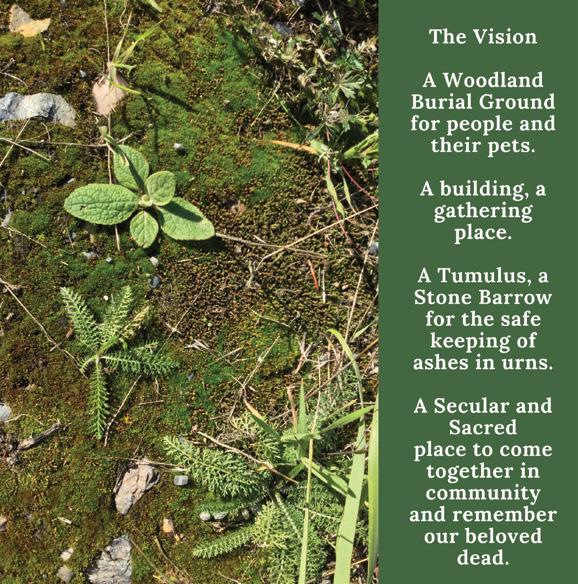
Illegal and Unsustainable Trade Threatens Otters

Article by Dr. Chris R. Shepherd and Lalita Gomez
There are 13 species of otters, all belonging to the subfamily Lutrinae. These largely aquatic carnivores are found on all continents, with the exception of the Antarctic and Australia (there are no otter species found east of the Wallace Line that runs through Indonesia). Like many carnivores around the world, the future for many otter species is threatened due to direct and indirect anthropogenic activities. Otters are threatened by habitat degradation, water pollution, channelization of waterways, conflict with fish farmers, loss of prey species, and illegal and unsustainable exploitation for commercial trade.
Of the 13 species of otters, seven of them are considered Threatened (Critically Endangered, Endangered, Vulnerable), five Near Threatened, and one, the North American river otter, is assessed as being Least Concern, by the IUCN Red List of Threatened Species (Table 1) The trade in otters In Asia, otter species are facing a perilous future due to the increasing loss of suitable habitat, the impact of pesticide use and human-otter conflict.This is exacerbated by an even more pressing and growing threat—the illegal wildlife trade. Hunting for commercial trade is considered a key reason for the depletion of otter populations across Asia. Otters are primarily traded live for the rapidly growing pet trade, for their skins used to make hats and other garments, and for their parts, which are used in traditional medicines. In fact, the pet trade, often carried out on the internet, is a rapidly increasing threat to a number of species. Online monitoring has shown hundreds of juveniles for sale, and anecdotal information suggests that much of this trade involves otters taken from the wild. In Indonesia alone, a four-month online survey, with just one hour of survey effort per week, revealed between 500-900 otters for sale. The Asian small-clawed otter, for example, is traded in growing numbers to supply demand for pets in Indonesia, Thailand, andJapan. Much of this trade is illegal but persists due to weak enforcement, corruption, and legal loopholes that are exploited by wildlife traffickers.
In other parts of the world, the fur trade has caused major declines in many species, such as the Giant otter and the Sea otter. While some species of otters have recovered from large-scale hunting and trapping for the fur trade, others continue to struggle.
Here in Canada, otters are trapped for their skins, which are used locally and exported. In 2017, Canada exported more than 10,000 otter skins, skin pieces, and garments made from otter skins. More than 8,500—the majority—of these were exported to China, and 1,000 were exported to the United States. Finland, Germany, and Iceland made up the remainder of importers of Canadian-sourced otters in that year. While River otter populations were significantly reduced by the late 1800s Species Range IUCN CITES Giant Otter Pteronura brasiliensis South America Endangered I North American River Otter Lontra canadensis North America Least Concern II Neotropical Otter Lontra longicaudis South America Near threatened I Marine Otter Lontra felina South America Endangered I Southern River Otter Lontra provocax South America Endangered I Sea Otter Enhydra lutris North America, Japan and, the Russian Federation Endangered II Spotted-necked Otter Hydrictis maculicollis Africa Near threatened II Hairy-nosed Otter Lutra sumatrana Asia Endangered II Eurasian Otter Lutra lutra Eurasia Near threatened I African clawless Otter Aonyx capensis Africa Near threatened I/II Congo clawless Otter Aonyx ongicus Africa Near threatened II Small-clawed Otter Aonyx cinereus Asia Vulnerable I Smooth-coated Otter Lutrogale perspicillata Asia Vulnerable I Table 1. Status of the world's otter species
Smooth-coated Otters have recently been listed in Appendix I of CITES, as international trade has become a serious threat to their continued survival. Photo: Nicole Duplaix.
due to over-trapping for trade, this species has recovered across much of its former range in Canada. They are found across all provinces and territories in Canada, although populations are fragmented in parts of this range. On Prince Edward Island, they have been extirpated. Otters and CITES
All otters are listed in the appendices of the Convention on International Trade in Endangered Species of Wild Fauna and Flora (CITES). Seven of those are listed in Appendix I, meaning no international commercial trade is permitted, and five are listed in Appendix II, meaning international commercial trade is permitted provided it is done so in accordance with national legislation. One species is listed in both Appendix I and II, depending on the range countries. Two species, the Smoothcoated otter and the Asian small-clawed otter, were only recently moved from Appendix II to Appendix I due to increasing threat from the international pet trade. In 2019, proposals for the up-listing of both these species were presented at the CITES Conference of the Parties (CoP 18) where the proposals gained sufficient support. As of November 26, 2019, the Appendix I listing for these two species went into force.
In 2018, The IUCN SSC Otter Specialist Group launched the Global Otter Conservation Strategy, with the first objective in the strategy being, “To rebuild and maintain healthy populations of all otter species across all parts of each species’ range as held before major human-induced declines.” The strategy can be viewed and downloaded at www.otterspecialistgroup.org/osg-newsite/ wp-content/uploads/2019/02/IUCN-OtterReport-On-Line-SP.pdf. Monitor is working on the implementation of key sections of the action plan, striving to ensure otters are adequately protected from illegal and unsustainable trade.
Endangered Species Day on May 15 is a reminder to learn about the importance of protecting endangered species and taking action to help protect them. -GG
Dr. Chris R. Shepherd and Lalita Gomez are members of the IUCN SSC Otter Specialist Group.Both work for the Monitor Conservation Research Society (Monitor) where Dr. Chris R. Shepherd is the Executive Director and Lalita Gomez is a Programme Officer and lead on otter-related work. For more info see Monitor’s website: www.mcrsociety.org or Facebook page www.facebook.com/mcrsociety/







